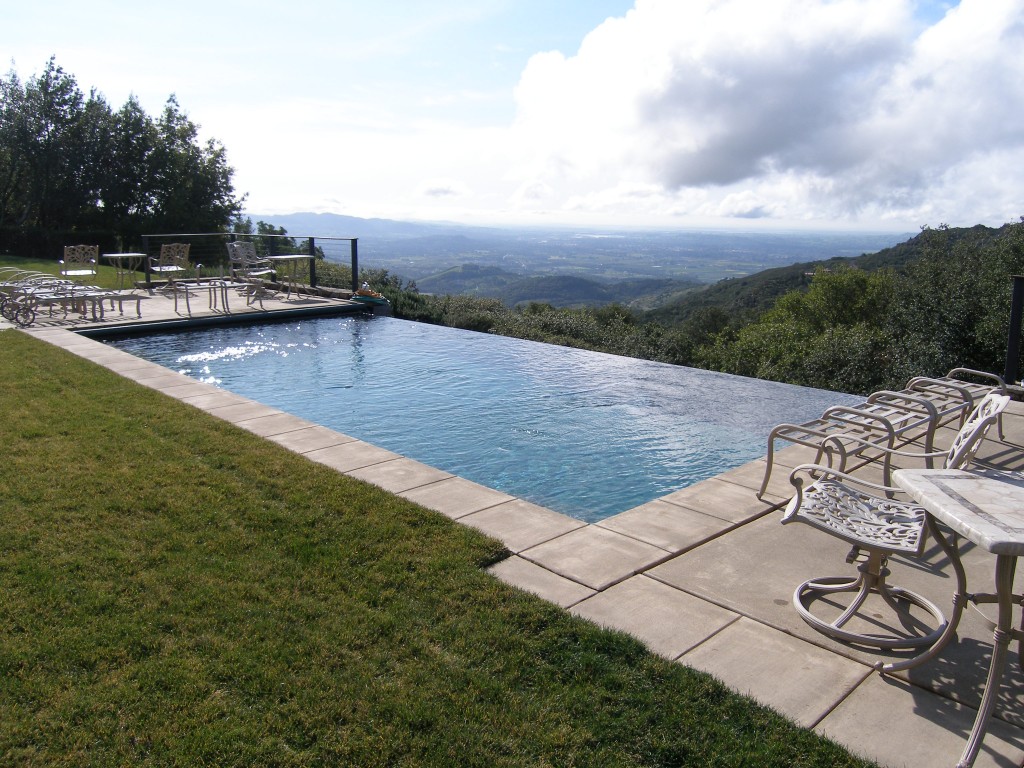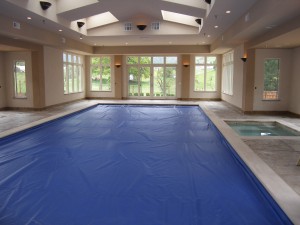
While chlorine has long been the standard in swimming pool sanitation, recent industry innovations have led to the development of alternative options. Photo: Classic Pools (2016)
Due to its superior disinfecting properties, chlorine has long been the standard in swimming pool sanitization. However, even though it’s effective at killing harmful germs and bacteria, it has one significant downside: it’s toxic to swimmers. Although it’s diluted to a safe level for pool use, a toxic chemical that’s watered down is still a toxic chemical, which is why many Bay Area pool owners have become interested in safer, alternative methods of sanitation. There are a number of options available, and each has specific pros and cons, so it’s important to do some research before making a decision. Here are a few common pool sanitation alternatives and some basic information about them:
Bromine
Bromine works similarly to chlorine in the way it reacts to swimming pool contaminants. The difference is that its byproduct (bromamine) is milder than chlorine’s (chloramine), which cuts down on effects like odor and eye and skin irritation. Additionally, bromine is more stable than chlorine (in warmer temperatures, at least), sanitizes for longer and is effective over a wider pH range. However, even though it’s a superior sanitizer, it’s a weak oxidizer, which is why it’s often applied in a hybrid form: tablets consisting of roughly 2/3 bromine and 1/3 chlorine. Also, unlike chlorine, bromine cannot be stabilized against UV light, which causes it to break down easily in outdoor pools. For this reason, bromine works best in indoor pools or covered spas. Even then, depending on the application, pool owners also need to consider the financial aspect, as bromine is more expensive than chlorine.

Bromine is a popular alternative to chlorine, but since it can’t be stabilized against UV light, it’s best applied to indoor pools or covered spas. Photo: Classic Pools (2016)
Ozone
Ozone is an active form of oxygen whose strength as an oxidizing agent can destroy contaminants and keep microorganism populations in check. When applied to pool sanitation, ozone is produced by an ozone generator, either via ultraviolet radiation or a high-voltage ionization process (aka corona discharge). While ozone is a far stronger oxidizer than chlorine (about 100 times more powerful), it’s not a complete sanitizer, which is why it’s usually paired with another type of sanitation, most commonly chlorine. All in all, an ozone generator is not meant to completely replace chlorine and additional chemicals, but to minimize the amount needed.
Ionizers
An ionizer uses electricity to produce copper and silver ions, which are charged in such a way that attracts bacteria, germs and algae toward a pool’s filtration system. Ionizers have several beneficial qualities, including being inexpensive to maintain, reducing the need for chemicals and having no negative effects on pool equipment. However, since ionizers are poor oxidizers, they require a supplemental agent—usually chlorine—to provide complete sanitation. Also, ionizers depend on moving water to be effective, so continuous pool pump operation is needed. Furthermore, the pool’s pH must be maintained within a certain range or copper staining will occur.
Chlorine
While reading through the preceding list, you may have noticed a recurring theme: each method requires a supplemental agent to maintain an adequate level of sanitation, and that agent is usually chlorine. It seems that despite its negative attributes, chlorine is all but unavoidable (at least in a small amount). So, rather than trying to avoid chlorine altogether, perhaps a better approach is seeking to apply it in the safest, most low-impact way possible.
To this end, it’s worthwhile to mention another sanitation alternative that’s steadily growing in popularity: salt chlorination. While it still involves the use of chlorine, the difference is in how a salt chlorinator produces and distributes the sanitizing chemical. Salt chlorination produces chlorine by electrolysis, which occurs when sodium chloride attaches to electrical plates. As the sodium breaks down, chloride molecules are released into the water. Unlike manually applied chlorine, which often causes chemical levels to spike, a salt chlorinator’s continuous, balanced delivery of chlorine reduces common side effects like overwhelming odors and eye and skin irritation.
One drawback cited by critics of salt water chlorination is that its saline content can cause premature corrosion of a pool’s metallic components. However, since salt chlorinated pools require relatively low levels of saline concentration, corrosion is more likely to result from extenuating factors like improper pool chemistry. As salt water chlorination continues to gain popularity as an alternative sanitation method, industry innovators look for new ways to minimize its potentially corrosive side effects.
To find a Diamond Certified swimming pool contractor or service company in your area, visit www.diamondcertified.info.
